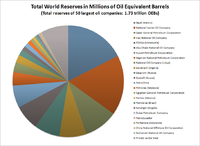
Photo from wikipedia
Flare is the last safety measure for daily operations in oil, gas & chemical process industries (OGCPI). However, an excessive flaring releases large quantity of emissions of VOCs and NOₓ,… Click to show full abstract
Flare is the last safety measure for daily operations in oil, gas & chemical process industries (OGCPI). However, an excessive flaring releases large quantity of emissions of VOCs and NOₓ, which may suddenly enhance local ozone as a secondary pollution. Normally, the flare destruction and removal efficiency (DRE) of 98% or 99% is regulated as the national standard and presumed for industrial practices in the U.S. Unfortunately, real DRE values could be much lower than the standard due to impact factors including various meteorological and operating conditions such as the cross-wind speed, flare jet velocity and heating value of combustion. Thus, it is critically important to explore the sensitivity of the regional ozone impact due to low DREs of OGCPI flare combustions. In this paper, a systematic methodology has been developed to examine ozone impacts due to the low flare DREs, which have never been systematically studied before. The DRE formulas were derived from computational fluid dynamic (CFD) modeling and Water Environment Research Foundation (WERF) results and then employed to recompile the point source emission inventory. After that, comprehensive air quality model with extensions (CAMx) was employede to simulate and quantify local ozone changes impacted by flare emissions of OGCPI. Case studies indicate that the maximum hourly ozone increments due to the low DRE through CFD and WERF modeling is 0.18 ppb and 1.3 ppb, respectively. This study could enrich fundamental understandings of industrial point source emissions and provide the quantitative and valuable support for the ozone pollution caused by OGCPI flare emissions under low DRE instead of standard values.
Journal Title: Atmospheric Environment
Year Published: 2020
Link to full text (if available)
Share on Social Media: Sign Up to like & get
recommendations!